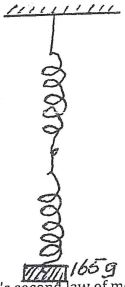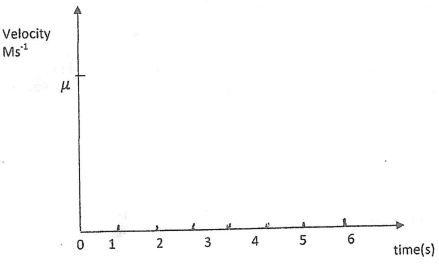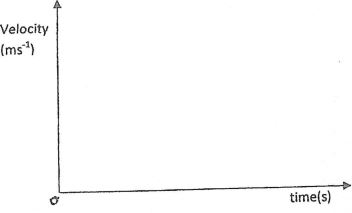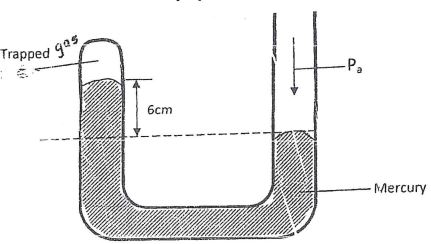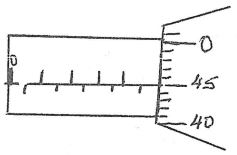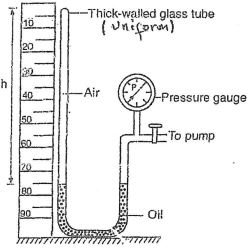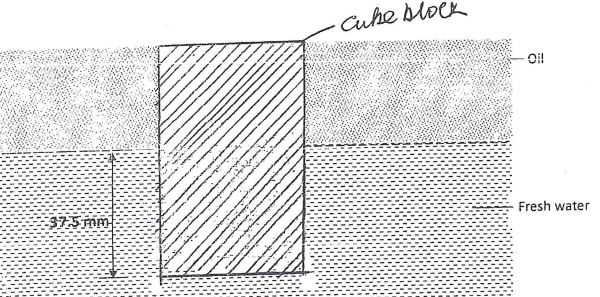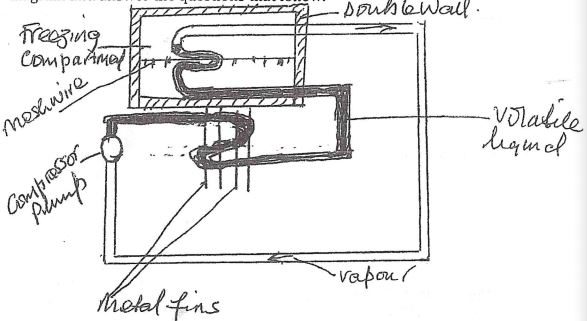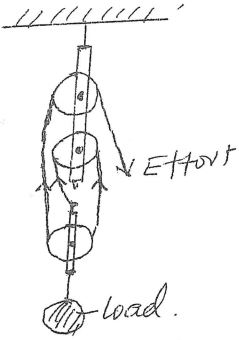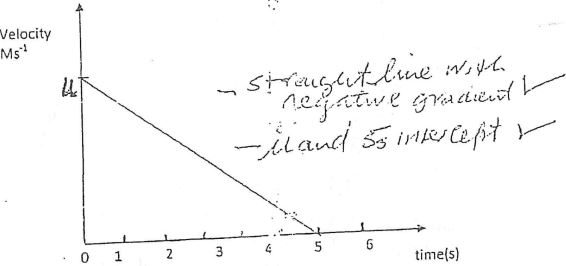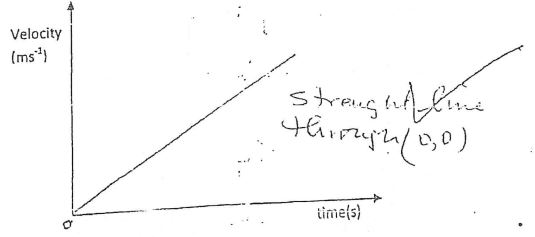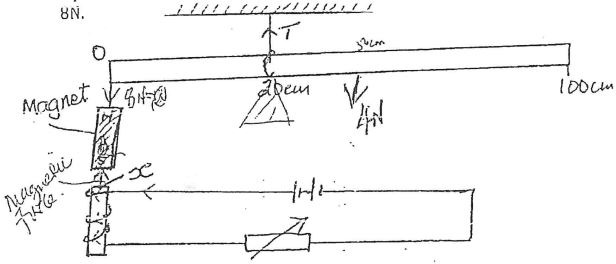Instructions to Candidates
- This paper consists of two sections; A and B.
- Answer ALL the questions in the spaces provided.
- Mathematical tables and electronic calculator may be used.
- You may use the following constants where necessary;
- Candidates should answer the questions in English.
SECTION A (25 MARKS)
- A pointer attached to a spring balance points to 21.5 cm on a scale when no weight is suspended from it. When a mass of 165g is hanged from it, it points 38.0 cm.
- Determine its spring constant. (2 marks)
- What would be the extension if two similar springs A and B in (a) above are used as shown below. (1 mark)
-
- State Newton's second law of motion. (1 mark)
- A resultant force of 10N acts on a body of mass 0.4kg starting from rest. Find the distance travelled after 10 seconds. (3 marks)
- 2.5 kg of water at 20°C is heated in an electric kettle connected to 250V supply. If it took 20 minutes to boil at 100°C specific heat capacity of water is 4200JKg−1 k−1. Determine the power of the kettle element. (3 marks)
- Sketch a velocity - time graph on the axes provided for
- an object thrown vertically upwards up to maximum height with initial velocity μ ms-1 and takes 5 seconds to reach maximum height. ( 2 mks)
- An object moving at constant acceleration from rest. (1 mark)
- A ball is thrown horizontally from the edge of a cliff at a velocity of 10ms−1 and hits the ground below after 10 seconds. Determine the height of the cliff. (2 marks)
- an object thrown vertically upwards up to maximum height with initial velocity μ ms-1 and takes 5 seconds to reach maximum height. ( 2 mks)
- State one condition necessary for a body to be in equilibrium. (1 mark)
-
- Define centripetal acceleration. (1 mark)
- An object of mass 0.4kg is moving in a horizontal circle of radius 24cm at a rate of 2 revolutions per second. Calculate its centripetal acceleration. (2 marks)
-
- State Pascal's Principle of transmission of pressure in liquids. (1 mark)
- The diagram below shows a mercury manometer with some dry gas trapped with the other limp open.
If the atmospheric pressure is 76cmHg and the density of mercury is 13600kgm-3. Determine the pressure of the trapped gas in cmHg (2 mark)
- A student used the measuring instrument below to measure the thickness of a cylindrical wire. If the wire is 10cm long, determine the volume of the wire. (3 marks)
- The figure below shows levels of water in two vertical tubes T1 and T2.
Explain why the level in T2 is lower than in tube T1 (2 marks)
SECTION B (45 MARKS)
-
- State the principle of moments. (1 mark)
(b) - A uniform light rod AB 50cm long in equilibrium when forces 3N, 5N and X acts on it as shown in the figure below. Find the magnitude of the force X
- The diagram below shows a suspended uniform beam of weight 4N in equilibrium under the action of the force shown. The weight of the magnet is 8N.
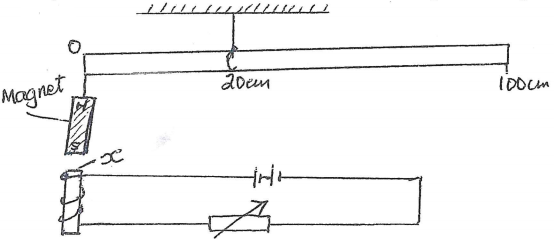
- Name the pole X. (1 mark)
- Indicate on the diagram all the forces acting on the beam. (2 marks)
- Calculate the force exerted by the electromagnet. (3 marks)
- State the principle of moments. (1 mark)
- A barrel is rolled up a ramp of 6m long, The barrel weighs 400N and is raised through a height of 1.5m. If a force of 120N is applied parallel to the inclined plane, calculate.
- The useful work done. (2 marks)
- The work input. (2 marks)
- The frictional force against motion of the barrel. (2 marks)
- Efficiency of the inclined plane. (3 marks)
-
- What do you understand by the term absolute zero temperature. (1 mark)
- Differentiate between ideal and real gases. (1 mark)
- The figure below shows a simple set up that may be used to verify Boyle's law.
Describe how the apparatus may be used to verify Boyle's law. (4 marks)
- Oil of density 800kgm-3 rests on the surface of water. A cube block of side 50mm floats by a distance of 37.5mm in the fresh water as shown in the figure.
Determine.- the upthrust on the block due to water. (2 marks)
- the upthrust on the block due to oil. (2 marks)
- the weight of the block. (2 marks)
- the density of the cube block. (2 marks)
- The diagram below shows the main features of a domestic refrigerator. Study the diagram and answer the questions that follow.
State the role of;- The compressor pump. (1 mark)
- The metal tins. (1 mark)
- The volatile liquid. (1 mark)
- Explain why the freezing compartment is located at the top of the refrigerator. (2 marks)
- An electric heater 1000W is used to heat 0.2kg of ice. Initially at -10°C to until all the mass changes to steam at 100°C.
Specific heat capacity of ice = 2.1 x 103 JKg-1K-1
Latent heat of fusion of ice = 3.34 x 105 JKg-1
Specific heat capacity of water = 4.2 x 103JKg-1K-1
Latent heat of vaporization of steam = 2.26 X 106Kg-1
Calculate:- The amount of heat required to raise the temperature of ice from -10°C to ice at 0°C. (2 marks)
- The amount of heat required to convert ice into water at 0°C. (2 marks)
- The amount of heat required to raise the temperature of water at 0°C to water at 100°C. (2 marks)
- The amount of heat required to change water to steam at 100°C. (2 marks)
- The minimum time required in minutes for activity in (i) to (iv) to take place (2 marks)
-
- What is a machine? (1 mark)
- The figure below shows a pulley system.
- State the velocity ratio of the pulley system, (1 mark)
- Explain what happens to the mechanical advantage of the machine as the load is increased gradually:
(1 mark)
- If an effort of 150N is used to raise a load of 450N using the pulley system in (b) above. Determine its
- Mechanical advantage (2 mark)
- The efficiency of the pulley. (2 marks)

Marking Scheme
- A pointer attached to a spring balance points to 21.5 cm on a scale when no weight is suspended from it. When a mass of 165g is hanged from it, it points 38.0 cm.
- Determine its spring constant. (2 marks)
e=38.0−21.5=16.5m=0.165m
k= 1.65N =10Nm−1
0.165m - What would be the extension if two similar springs A and B in (a) above are used as shown below. (1 mark)
K2= 10×10 5N/M
10+10
∴et= F =1.65N
KT 5N/M
=0.33m
OR
e=2×0.165m
=0.33m
- Determine its spring constant. (2 marks)
-
- State Newton's second law of motion. (1 mark)
- The acceleration of a body is directly proportional to the force applied and inversely proportional to the mass of the body .
- A resultant force of 10N acts on a body of mass 0.4kg starting from rest. Find the distance travelled after 10 seconds. (3 marks)
a=F = 10m =25ms−2
M 0.4kg
s=½at2
=½×25×10×10
=1250m
- State Newton's second law of motion. (1 mark)
- 2.5 kg of water at 20°C is heated in an electric kettle connected to 250V supply. If it took 20 minutes to boil at 100°C specific heat capacity of water is 4200JKg−1 k−1. Determine the power of the kettle element. (3 marks)
Heat gained by water=Mcθ
=2.5kg × 4200JKg−1 k−1×80K
=840,000J
P =840000 =700W
20×60 - Sketch a velocity - time graph on the axes provided for
- an object thrown vertically upwards up to maximum height with initial velocity μ ms-1 and takes 5 seconds to reach maximum height. ( 2 mks)
- An object moving at constant acceleration from rest. (1 mark)
- A ball is thrown horizontally from the edge of a cliff at a velocity of 10ms−1 and hits the ground below after 10 seconds. Determine the height of the cliff. (2 marks)
h=½gt2
=½×10ms−2×10×10
=500m
- an object thrown vertically upwards up to maximum height with initial velocity μ ms-1 and takes 5 seconds to reach maximum height. ( 2 mks)
- State one condition necessary for a body to be in equilibrium. (1 mark)
- Sum clockwise moment=sum of anticlockwise moment
- Sum of upwad forces=sum of downward forces
- Resultant force is zero
-
- Define centripetal acceleration. (1 mark)
- Acceleration produced by centripetal force and always directed to the centre of the circle of rotation
- An object of mass 0.4kg is moving in a horizontal circle of radius 24cm at a rate of 2 revolutions per second. Calculate its centripetal acceleration. (2 marks)
w=2πr
=2×3.142×2HΖ
=12.568
G=w2r
=12.568×12.586×0.24m
=37.91ms−2
- Define centripetal acceleration. (1 mark)
-
- State Pascal's Principle of transmission of pressure in liquids. (1 mark)
- Pressure exerted at one part of an enclosed liquid is equally transmitted to all parts.
- The diagram below shows a mercury manometer with some dry gas trapped with the other limp open.
If the atmospheric pressure is 76cmHg and the density of mercury is 13600kgm-3. Determine the pressure of the trapped gas in cmHg (1 mark)
76cmHg−6cmHg
=70cmHg
- State Pascal's Principle of transmission of pressure in liquids. (1 mark)
- A student used the measuring instrument below to measure the thickness of a cylindrical wire. If the wire is 10cm long, determine the volume of the wire. (3 marks)
Reading=(4.5+0.45)mm
D=4.95mm
r=2.475mm
=0.2475cm
v=πr2L
=3.142 × 0.24752 × 10
=1.925cm3 - The figure below shows levels of water in two vertical tubes T1 and T2.
Explain why the level in T2 is lower than in tube T1 (2 marks)- Velocity increases causing a corresponding decrease in pressure making pressure at T2 less than at T1
SECTION B (45 MARKS)
-
- State the principle of moments. (1 mark)
- For a system in equilibrium the sum of the clockwise moments is equal to the sum of anticlockwise moment about the same point.
- A uniform light rod AB 50cm long in equilibrium when forces 3N, 5N and X acts on it as shown in the figure below.
(x × 0.1m) = (5.1 × 0.05m) +3N ×0.23
0.1x=0.25NM + 0.75NM
0.1x=1.0NM
x=10N - The diagram below shows a suspended uniform beam of weight 4N in equilibrium under the action of the force shown. The weight of the magnet is 8N.
- Name the pole X. South (1 mark)
- Indicate on the diagram all the forces acting on the beam. (2 marks)
- Weight 4N, electromagnet/magnetic force and weight of magnet
- Calculate the force exerted by the electromagnet. (3 marks)
(4N×0.3m) + (x × 0.2m) =8N×0.2
1.2Nm+0.2xm=1.6Nm
0.2xm=0.4Nm
x=2N
- State the principle of moments. (1 mark)
- A barrel is rolled up a ramp of 6m long, The barrel weighs 400N and is raised through a height of 1.5m. If a force of 120N is applied parallel to the inclined plane, calculate.
- The useful work done. (2 marks)
P.e=mgh=400N × 1.5m
=600J - The work input. (2 marks)
F × d=120N × 6m
=720J - The frictional force against motion of the barrel. (2 marks)
Work against friction=w−work
wFr =(720−600)J
= 120N =20N
6m - Efficiency of the inclined plane. (3 marks)
Work output ×100 = 600/720 ×100
Work put
=83.33%
- The useful work done. (2 marks)
-
- What do you understand by the term absolute zero temperature. (1 mark)
- Lowest temperature possible measured on kelvin scale
- Temperature when the pressure is zero
- Temperature when volume or K.E is zero
- Differentiate between ideal and real gases. (1 mark)
Ideal gases Real gases -Obey gas laws completely
-Remain gases to Ok-Don't obey gas laws
-Liquify before OK - The figure below shows a simple set up that may be used to verify Boyle's law.
Describe how the apparatus may be used to verify Boyle's law. (4 marks)- Set up apparatus as shown.
- Pumpthe air until a measurable layer of oil is reached
- Allow the trapped air to adjust to room temperature and record pressure and height a (volumer). Repeat for other values of pressure nad weight in (volumer)
- A graph 1/volume of in a straight line through(90) i.e pressure × 1/volume
- What do you understand by the term absolute zero temperature. (1 mark)
- Oil of density 800kgm-3 rests on the surface of water. A cube block of side 50mm floats by a distance of 37.5mm in the fresh water as shown in the figure.
Determine.- the upthrust on the block due to water. (2 marks)
Uw=v × P × g =0.052 ×0.0375×1000kg−3× 10NKg−1
=9.375 × 10−1N =0.9375N - the upthrust on the block due to oil. (2 marks)
Uoil v × P × g = 0.052 × 0.0125 × 800kg × 10NKg−1
= 2.5 × 10−1N =0.52N - the weight of the block. (2 marks)
w=(99.375 +2.5) × 10−1
=1.188N - the density of the cube block. (2 marks)
eblock = mass = 0.11875kg
volume 0.053
=950Kgm−3
- the upthrust on the block due to water. (2 marks)
- The diagram below shows the main features of a domestic refrigerator. Study the diagram and answer the questions that follow.
State the role of;- The compressor pump. (1 mark)
- Compresses and condenses vapour from evaporating liquid.
- The metal tins. (1 mark)
- Conduct latent heat from the condensing vapour away
- The volatile liquid. (1 mark)
- Evaporate and take away latent heat from the pipes and surrounding air causing cooling
- Explain why the freezing compartment is located at the top of the refrigerator. (2 marks)
- To allow a cold conventional air current from top to bottom cooling the inside of the refrigerator
- The compressor pump. (1 mark)
- An electric heater 1000W is used to heat 0.2kg of ice. Initially at -10°C to until all the mass changes to steam at 100°C.
Specific heat capacity of ice = 2.1 x 103JKg-1K-1
Latent heat of fusion of ice = 3.34 x 105JKg-1
Specific heat capacity of water = 4.2 x 103JKg-1K-1
Latent heat of vaporization of steam = 2.26 X 106Kg-1
Calculate:- The amount of heat required to raise the temperature of ice from -10°C to ice at 0°C. (2 marks)
=Mice x Cice x θ
=0.2kg x 2.1 x 103 JKg-1K-1 x 10K
=4.2 x 103J
=4200J - The amount of heat required to convert ice into water at 0°C. (2 marks)
=MwLf
=0.2Kg x 3.34 x 105JKg-1
=6.68 x 104J
=66,800J - The amount of heat required to raise the temperature of water at 0°C to water at 100°C. (2 marks)
=MwC10 x θ
=0.2 x 4.2 x 105JKg-1K-1 100K
=8.4 x 104J
=84,000J - The amount of heat required to change water to steam at 100°C. (2 marks)
=MLv
=0.2Kg x 2.26 x 106JKg-1K-1
=4.52 x 105J
=452,000J - The minimum time required in minutes for activity in (i) to (iv) to take place (2 marks)
Total heat=4.2 x 105J +6.68 x 104J + 8.4 x 10J +4.52 x 105J
= 6.07x 105J
t=Total heat = 6.07x 105J = 607s
Power 1000w
In minutes =10 minutes 7seconds
=10.117 minutes
- The amount of heat required to raise the temperature of ice from -10°C to ice at 0°C. (2 marks)
-
- What is a machine? (1 mark)
- A device that enables work to be done more easily or conveniently
- The figure below shows a pulley system.
- State the velocity ratio of the pulley system, (1 mark)
- 3
- Explain what happens to the mechanical advantage of the machine as the load is increased gradually:
(1 mark)- Mechanical advantage increases with the load and becomes constant and maximum load the machine can support.
- State the velocity ratio of the pulley system, (1 mark)
- If an effort of 150N is used to raise a load of 450N using the pulley system in (b) above. Determine its
- Mechanical advantage (2 mark)
M.A = L = 950N = 3
E 150N - The efficiency of the pulley. (2 marks)
Efficiency =M.A × 100
V.R
=3/3 × 100
=100
- Mechanical advantage (2 mark)
- What is a machine? (1 mark)
Download Physics Paper 1 Questions and Answers - Moi Kabarak High School Mock 2020/2021.
Tap Here to Download for 50/-
Get on WhatsApp for 50/-
Why download?
- ✔ To read offline at any time.
- ✔ To Print at your convenience
- ✔ Share Easily with Friends / Students

